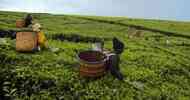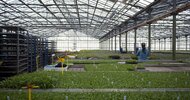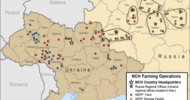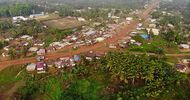In the wake of the 2008 global food crisis, African capitals have been buzzing with renewed talk of the need for food self-sufficiency, and rice is often at the top of government agendas. Although everyone agrees on the need to increase production, the solutions coming out of the corridors of power boil down to the tired old formula of getting more fertilisers and “high-yielding” seeds to farmers. In the eyes of the decision-makers, this inevitably means either Chinese hybrid rice seeds or the Nerica rice seeds developed by the African Rice Centre, and backed by the most powerful donors and research institutes operating on the continent.[1] The traditional knowledge and seeds of African farmers, which feed and provide livelihoods for the majority of people on the continent, are completely ignored.
Just as troubling, and not disconnected from this top-down seeds push, is a rush for control over Africa’s farm lands. While African governments proclaim their commitments to food self-sufficiency, behind the backs of their people they are signing an alarming number of deals with foreign investors that give these investors control over their countries’ most important agricultural lands, including rice lands.[2]
Take Mali for example. Mali, like several other countries in West Africa, recently went from being a net rice exporter to being a major importer. Now the government has embarked on a multimillion-dollar national rice initiative that is supposed to restore self-sufficiency by helping the country’s farmers to produce more. Why then has the government handed over an enormous tract of prime rice land to a Libyan investment fund and Chinese companies?
A couple of years ago, on the sidelines of a summit of the Community of Sahel-Saharan States (CEN-SAD) in Bamako, Mali’s President, Amadou Toumani Touré, offered up 100,000 ha of land within the Office du Niger, Mali’s main rice producing area. Libya, a country flush with petrodollars but lacking in its own food production, effectively runs CEN-SAD and it jumped at the chance. Through an arm of its sovereign wealth fund,[3] the Libya Africa Investment Portfolio (LAP), Libya signed a deal with Mali giving Libya control over the 100,000 ha as part of a larger infrastructure investment project for the area that includes the enlargement of a canal and the improvement of a road. The project will begin with rice production and will eventually add tomato production and livestock.
Details of the how the project will operate are finally starting to emerge. LAP’s subsidiary in Bamako, Malibya, is responsible for managing the project. The infrastructure construction has been contracted to CGC, a Chinese company owned by China’s big oil corporation SINOPEC.[4] Another, unnamed, Chinese firm has been contracted to supply Chinese hybrid rice seeds for the project and to train local experts, some of whom are already in China, on how to cultivate them. This unnamed company is likely to be China’s largest hybrid rice seed producer, Yuan Longping High-tech Agriculture, which already has extensive programmes in Africa and a similar CGC project for hybrid rice production in Nigeria.[5]
This is not the first big investment in hybrid rice production in West Africa for Libya’s sovereign wealth enterprise. In December 2007, LAP invested US$30 million in a rice project in Liberia that it will manage in partnership with the local NGO Foundation for African Development Aid (ADA) on 15–17,000 ha of land that ADA had received from the Liberian government.[6]
In both instances, the stated objective of the project is to help to meet local food needs. Yet there is plenty of reason to suspect that the real motivation is to export rice to Libya. In 2005, the latest year for which data is available from the FAO, Libya imported 177,000 tonnes of rice, valued at US$62 million. Those imports will certainly expand, as Tripoli moves forward with an ambitious US$130-billion infrastructure development programme that is forecast to require a million foreign workers, most of whom will come from Asia.[7] In December 2008, Libya signed an agreement with Bangladesh for the recruitment of a “large number” of workers. Libya, like other Arab countries, is seeking to escape its dependence on corporate-controlled global commodity chains for its food needs by outsourcing food production to other countries.[8] “Ensuring food security in rice also makes it possible to overcome another major difficulty: that is to say, the developed countries that monopolise agriculture production and the global companies that monopolise the prices of staple foods”, says Malibya’s director, Abdalilah Youssef.[9]
The vice-president of the LAP told the Liberian Times in December 2007 that their project in Liberia would target both local and international markets.[10] With the Mali project, although the priority for the project is said to be the domestic rice market, there are clear signs that exports to Libya are part of the plan. During a visit to Mali, Amadou Kanté dit Bany, a senior director with LAP, told L’Indépendant newspaper that the project would produce rice “to meet the needs of Mali, Libya and all other countries of CEN-SAD”.[11]
Wherever the rice goes, however, its production will do little for local farmers. Indeed, in Mali the project is going to push some local farmers off the land and compete directly with others for water from the Niger river, the most important source of irrigation for the Sahel–Sahara. Already, Malibya is negotiating with the Malian government for priority in water allocation during the off-season, when the water levels are low.
“When it comes to the reorganisation of people, meaning the villages that will have to leave their area, I say that any arrangement creates a disturbance, and I am asking for everyone’s cooperation in this regard. For us this is not about chasing away the people or evacuating them, but simply about reorganising them”, says Malibya’s Abdalilah Youssef.[12]
Mamadou Goita, executive director of the Institute for Research and the Promotion of Alternatives in Development in Mali, places the Malibya project within a larger reorganisation of the Office du Niger that is paving the way for the private sector to take control of farm land. “The projects in the Office du Niger, such as the Malibya project and projects financed by way of the US government’s Millennium Challenge Account, are brutally pushing forward the industrialisation of agriculture and the privatisation of lands in the area”, he says. Indeed, earlier this month, Lonrho, a London-based conglomerate, announced that it was in talks with the Malian government for a 25,000-ha rice project in the Office du Niger. This is in addition to a 25,000-ha rice-land deal that Lonrho has just concluded with Angola and a 100,000-ha land deal that it is negotiating in Malawi.[13]
There are also concerns about how these projects are destroying the area’s rich diversity of local rice by promoting a few modern varieties, notably the Nerica varieties developed by the African Rice Centre. As reported in the recent GRAIN Briefing on Nerica, the widespread and heavy promotion of Nerica in Africa poses a major threat to the continent’s farmer seed systems, which continue to supply up to 90 per cent of its seed needs. Dr Assetou Samaké, professor of plant genetics at the University of Bamako and a member of the Coalition for the Protection of African Genetic Heritage (COPAGEN), says that, in the area of the Office du Niger, Nerica is now displacing local varieties. She also says that the zone has been turned into a “forest of experiments” with no transparency about what seeds are being brought in, and she worries that it could become a testing ground for GMOs and hybrid seeds.
In the case of the LAP projects in Mali and Liberia, they will both be supplied with imported Chinese hybrid rice seeds. Hybrid rice can achieve high yields, but only when high-tech machinery and high levels of chemical inputs are used.[14] As well as that, seeds from hybrid rice cannot be saved by farmers but have to be purchased every year, putting them out of reach and making them impractical for Liberia’s or Mali’s small farmers. Moreover, while its poor eating quality is a major deterrent to small farmers supplying local markets, hybrid rice is less of a problem when the goal is to supply migrant labourers with a cheap food source, which is likely to be the case with the LAP projects in Mali and Liberia. The LAP’s use of hybrid rice could open the door to more large-scale hybrid-rice projects, setting a dangerous precedent for West African rice farmers and their seed systems.
In early 2007, more than 500 people representing farmers, fisherfolk, indigenous peoples, food workers and civil society organisations from around the world gathered in Nyéléni, Mali to strengthen the global movement for food sovereignty.[15] They declared: “Most of us are food producers and are ready, able and willing to feed all the world’s peoples.” This movement is growing and gathering force, but so too are the forces threatening to take away the seeds and lands of small-scale food producers – the very basis of their capacity to feed people and to assure their livelihoods. The conflict between the two visions for the future of food and farming is a gathering storm that the flimsy “win–win” cover used by Libya and the other land grabbers will be unable to protect against – and the skies above Africa are clouding over.
Further reading
GRAIN, “Seized: The 2008 landgrab for food and financial security”, October 2008, http://www.grain.org/briefings/?id=212
GRAIN, “Nerica: another trap for small farmers in Africa”, January 2009, http://www.grain.org/briefings/?id=215
GRAIN, “Oryza hybrida blog – Information and analysis for the resistance to hybrid rice”, http://www.grain.org/hybridrice/?blog
GRAIN, “Seed aid, agribusiness and the food crisis”, Seedling, October 2008, http://www.grain.org/seedling/?id=564
GRAIN, “The food crisis and the hybrid rice surge”, Seedling, July 2008, http://www.grain.org/seedling/?id=551
[1] See the GRAIN briefing, “Nerica: another trap for small farmers in Africa”, January 2009, http://www.grain.org/briefings/?id=215
[2] See GRAIN, Oryza hybrida blog, “Mali: a Libya–Chinese rice landgrab strikes a blow to local farmers”, posted 1 December 2008, http://www.grain.org/hybridrice/?lid=212
[3] Libya’ sovereign wealth fund is the Libyan Investment Authority.
[4] Temoust., “Signature de convention entre la Chine, la Libya et le Mali”, 3 November 2008, http://www.temoust.org/spip.php?article7056
[5] Organization, CGC Overseas Construction Nigeria Co. Ltd, http://www.cgcoc.com.cn/en/org_content.asp?classid=L290202&newsid=712231659508670
[6] Cheetah Index, “$30m Libyan Investment in Rice Growing for Liberia”, Tripoli Post, 23 December 2007, http://business.africanpath.com/article.cfm?articleID=48228
[7] Libyaonline.com, “Libya to recruit large number of workers”, 13 October 2008, http://www.libyaonline.com/business/details.php?id=6433
[8] GRAIN, “Seized: The 2008 landgrab for food and financial security”, October 2008, http://www.grain.org/briefings/?id=212
[9] Maliweb, interview with Abdalilah Youssef, 10 November 2008, http://www.maliweb.net/category.php?NID=37605
[10] ReliefWeb, “Liberia: Liberia offers to assist Liberia in rice production”, Liberian Times, 17 December 2008, http://www.reliefweb.int/rw/rwb.nsf/db900sid/KKAA-79Z8B6?OpenDocument
[11] Temoust, “Les investissements libyens sont une aubaine pour le Mali" , 15 May 2008, http://www.temoust.org/spip.php?article5388
[12] Maliweb, interview with Abdalilah Youssef, 10 November 2008, http://www.maliweb.net/category.php?NID=37605
[13] Tom Burgis “Lonrho secures rice land deal in Angola”, Financial Times, 16 January 2009. http://farmlandgrab.blogspot.com/search/label/Angola
[14] GRAIN, Oryza hybrida blog – Information and analysis for the resistance to hybrid rice, http://www.grain.org/hybridrice/?blog
[15] See the Nyéléni conference website at http://www.nyeleni.org













